3 Tips to Never Write Copy from Scratch Again
September 25, 2019

Okay, honest millennial question here:
What is that ONE THING you ALWAYS have to Google?
You know what I’m talking about. That thing you should know how to do, but you find yourself Googling it every single time it pops up?
For me, it used to be taking a screenshot on my Macbook.
Screenshots are a part of daily life for me, now, but when I was teaching, it seemed like I only needed to take one every now and then.
Every. Single. Dang. Time. I had to type into the search bar, “How to screenshot on a Macbook.”
That little helpful Google box with all the answers would tell me – probably with a heavy sigh, if technology could do that – comm + shift + 4.
Now I’m really curious to hear what yours is. How long to hard boil eggs? What’s the number for 9-1-1?
Okay, just kidding.
But, I can’t help but think this is the exact approach that many of you take to writing copy for your business.
Almost daily, I get a DM or email from someone who says,
“I know how to write, it just doesn’t come naturally to me.”
OR
“I never signed up to be a writer, I don’t even know where to start!”
And while these are two totally different places you might be coming from, the core issue is the same:
You struggle with copy because you’re probably starting from scratch.
What do you do when something’s hard for you, but you have to do it anyway? You come up with a system, you develop a process, that way you don’t have to use all your smarts for every single step of the way.
This is not only true for writing, it’s true for daily life, too!
Have trouble getting up in the morning to go to the gym?
System: Set out your clothes, put your phone a step or two away from your bed, fill your water bottle and put it in the fridge.
Want to have deep conversation with your husband at dinner?
System: Have some broad, but meaningful questions you always ask each other to get things rolling. My favorites: What was one thing that made your happy today? What was one thing that frustrated you today?
I could obviously go on, but you get the point. If we want to consistently reach a valuable, worthwhile, but slightly difficult goal, we have to help ourselves by setting up a process to make it happen consistently.
I’m a copywriter for a living, and I rarely, if ever, start from scratch on copy.
When I first started out, I researched, studied, and reverse-engineered websites and sales pages until I noticed the similarities, differences, and non-negotiables of each medium.
I taught my Creative Writing students to use the same tactic with “mentor texts.” Before any assignment or new project, we would study great examples and inspiration, and then we would create from that structure or jumping-off point.
In this blog post, I’m going to share the three key things you need in your business so you never have to write copy again. We’re gonna get a little nerdy today, so stick with me. But, I promise your writing will come so much easier with these things in place, which means you’ll show up more, exuding confidence and creativity, because your brain isn’t spending all it’s time starting from ground zero.
3 Things You Need to Never Write Copy from Scratch Again
Create an outline/template.
But, Jess, if I work from an outline, won’t all my stuff sound the same?
I have two answers for you:
Yes, it might.
If all of your Instagram posts and blogs follow the same format, GOOD. You’ll have a better chance at becoming more recognizable and memorable to your audience. They’ll know what to expect. They’ll know how to follow along, and when you expect them to engage (and if you’ll engage back!). Consistency is good! Embrace it.
But, no, it won’t.
When you use an outline, it’ll become so ingrained in your brain, that you’ll know when your ideas warrant breaking the form, or when they’re fine in the normal structure.
Plus, having an outline actually gives your brain more space for creativity because it’s not spending every bit of time trying to think about what to write instead of having fun with how you write it.
“Creativity is a habit, and the best creativity is the result of good work habits.” -Twyla Tharp
The people who don’t show up because they’re too busy thinking about how to be creative and do things differently aren’t the ones who are actually innovating. Innovation means showing up consistently until the creative idea meets you there. It means taking action, not sitting and waiting for ideas to happen.
Creating outlines is a great way to make sure you can show up to the page, to the post, to the email sequence, whatever. Then, once you’re there and in the groove? Guess who might come sit with you? Yep. Creativity.
4 Pro Tips for Creating Outlines that Save You Time
Go outside your industry for inspiration.
Please, please don’t go create a weekly newsletter outline from your neighbor in your exact same industry. Even if your heart is to go in from an objective standpoint, it’s far too easy to straight up copy. PLUS, if your stuff looks just like others in your industry, you’ll start to attract price shoppers instead of FOREVER FANS and readers who want to pick up every single thing you drop.
Some of my favorite newsletters to get the creative juices pumpin’: Seth Godin, Austin Kleon, Reina Pomeroy (download the CEO report to get on her list – it’s 🙌🏻), Megan Martin, Natalie Franke, With Grace and Gold.
Name the “what,” not the “how.”
For example, if I analyzed With Grace and Gold’s newsletter, the very first thing I would bullet-point is “inspirational or relatable quote to guide the conversation.” I’m not noting what quote they pulled. I simply note the function of their very first section of copy, what it is + what it does, and then I move on to the next piece.
I actually had my high school students do this very thing when we were analyzing text for essay writing. They always wanted to go straight to interpretation – to saying what they had to say about the text. BUT, before they could ever interpret, they had to name what was happening. They would say, “This sounds really joyful, but also has a splash of cynicism.” And, I would say, “What sounds like that? What word led you to believe that? Name it.” Outlines are less interpretation, and more naming. Keep it simple.
Now, it’s important to note here, just because I analyze another newsletter in the order it appears doesn’t necessarily mean I will use it in that same order. This is where it comes down to knowing your audience. For me, my audience really likes to hear a story first. So, I might love the idea of providing an inspirational quote to guide conversation, but I would likely pull it in after my story. That’s where the creativity comes in – see?
Each time you use the outline, notice what you have to keep adding in – then tweak + change.
It’s inevitable. Any time you create a process or a system, you’re going to be adding and tweaking for a little bit. You also might hit a different stage in business where you want to switch some things around to align with your pivot.
HEAR ME OUT: Just because things change does not mean you should never try to systemize them. It will still save you time and brain space if you give yourself a place to start instead of needing to imagine where to begin, again and again.
Keep them close to where you write your copy.
I keep my outlines in Asana or Google Docs. That’s where I write and plan all my content.
Takeaway: Keep it where you’ll use it.
I keep my social media outlines in Asana, because that’s where I do most of my planning.
I keep my blog outline in a Google Doc that I duplicate every time I go to write a blog post.
I keep my sales page, website copy, email sequence outlines in my Google Folder for internal client templates, that way I can duplicate any time I’m creating one for a client.
Yep, you heard that right – I use outlines for my clients, even as a pro copywriter.
Why? Because I like to work smarter, not harder. I know having a place to start will ensure I’m being intentional with strategy, thinking about why things should or shouldn’t go in a certain order. I start with the outline, and always take creative liberties, based on the research and foundation for each and every brand. And guess what? All the end products look extremely different, even though they come from the same process.
Outlines are different than templates. Templates are fill-in-the-blank. I’m not talking about canned emails, here.
Outlines are necessary as training wheels or bowling bumpers – bless those things.
They’re for the things you write on a daily or weekly basis, that need different content every single time. Think: Instagram captions, email newsletter broadcasts, sales pages, blog posts, etc.
Sometimes outlines are known as “formulas,” and while I do use formulas to craft my outlines, I like to make mine a little more detailed for simplicity’s sake.
Remember, Einstein said,
“Everything must be made as simple as possible, but not simpler.”
Ready to write your own templates?
Grab my free how-to guide here.
Utilize a copy bank.
I’m sure you’ve heard this tip before, but I’m always shocked at how few of you are utilizing this amazing tool!
When I taught high school, I used to get ideas for lessons, literally everywhere. I would write them down in a note on my iPhone, but inevitably, I would never go back to that note and it would go unused.
When I started my business, I felt myself moving in the same direction, so I decided to start experimenting with cataloguing things in a way that makes it a whole lot easier to use.
Enter: Asana.
I use Asana as my task management tool, and I have a specific board titled “Story Bank.”
You can experiment with different category types. I like a mixture of life categories that I can pull from seasonally, but also categories that apply to my direct area of content + education.
You can steal my process…
Step 1: Document On-The-Go
When I’m out and about, living my very movie-worthy life, I pull out my phone and click the Asana app on occasion when something notable happens. I title the card with a little snippet of the general story, then I keep shopping in Target (because let’s be honest, I get most of my epiphanies there).
Pro Tip: If you have just a second longer, include a sentence or a few words of how that relates to your audience, your area of expertise, or what you learned from that story. Otherwise, it’s like that stack of sticky notes that are uninterpretable the next day – useless.
Step 2: Fill in the details weekly (ish)
I have a task during my Marketing Mondays (a.k.a. My business writing days) where I go through my story bank for about 30 minutes and flesh out the stories a little more, while they’re still fresh.
Step 3: Swipe like a total boss
Next time you need a little boost in your copy, a story lead-in, or a good conversation topic, head to your story bank + swipe. BOOM.
Create + use a brand messaging guide.
If you’re busy wondering, “hmm… does this sound like me + my brand?” – you need a brand story + messaging guide.
The MOST difficult things to start from scratch with? The foundational stuff.
I’m talkin’ your mission statement, your vision, your unique value proposition, company values. All of that stuff that sounds super sexy, but when you sit down to think about it, do you just want to hide in a closet and scroll relatable quotes on PInterest so you don’t feel so lost?
Yeah, you shouldn’t have to start over with that stuff all the time!
A brand story + messaging guide is something we provide all of our copywriting clients, and I can’t even tell you how often I get a message saying, “I went to write my own _______ and it was just SO EASY with the brand messaging guide right next to me!”
Take some time to get the big stuff down on a Google doc. Then, practice having it next to you next time you write something. You might be surprised how easy it is to connect with your people when you remember how you, your business, and your readers all come together.
So, tell me:
Do you use any of these bowling bumpers for your business? If not, which one will you put in place first?

I’m Jess,
iced-coffee-obsessed, saved-by-grace, allergic-to-small talk, and one of the biggest dreamers you’ll ever meet.
Leave a Reply
It’s the very first solution of its kind to help you take #alltheideas inside your head and turn them into website copy that connects, converts, and doesn’t sound like literally everyone else’s.
Think your copy needs a makeover? Then, it probably does.
You’ve gotta capture, connect, and convert—FAST. No big deal, right?
SHOP THE PROMPTLATES
Introducing: The Promptlate Shop

Hello, Jess! Just found you via Pinterest and appreciate this article. I have heard of developing a story bank, but I found that I didn’t have any story worthy things to add to it so gave up. Perhaps I am not as insightful as I would like to be. Our minister comes up with great stories and ties things into his message so well..I marvel at his skill. I freak out when it comes to writing…I feel I really don’t have much to say and half the time I can’t recall any meaningful connections between things that happen in my life and how those things relate to my audience. UGH! I want to give the story bank a try. I love your outline idea. I have never tried to use an outline to approach my blog post or email writing. I will give this a try and see how it goes. Thanks so much for your expertise and insight!! 🤗
Hey there!
I’m so glad you’re here! The only difference between something "story worthy" or not is how you tell it. A great book I highly recommend is "Made to Stick" by Dan and Chip Heath. They talk about why some ideas "stick" and others don’t! I would start out practicing telling a story a week, just on paper, and forcing a connection between your content area. It can be bad. You can crumple it and throw it away. But, it’ll start to train that muscle, and remind you that your "mundane" might be exactly what someone needs to hear for something to "click!"